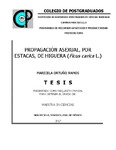| dc.contributor.author | Ortuño Ramos, Maricela | |
| dc.creator | ORTUÑO RAMOS, MARICELA | |
| dc.date.accessioned | 2019-07-24T18:41:29Z | |
| dc.date.available | 2019-07-24T18:41:29Z | |
| dc.date.issued | 2017-07 | |
| dc.identifier.uri | http://hdl.handle.net/10521/3653 | |
| dc.description | Tesis (Maestría en Ciencias, especialista en Fruticultura).- Colegio de Postgraduados, 2017. | es_MX |
| dc.description.abstract | El cultivo de higuera en México ha cobrado gran importancia, en los inicios de la explotación se introdujo el cultivo a cielo abierto, pero la planta es muy dulce y presenta características que la hacen muy propensa al ataque de plagas y enfermedades, por lo que su explotación resultó poco rentable, debido al ataque del barrenador del tallo (Azochis gripusalis) y problemas de hongos en raíz (Aspergillus y Fusarium). Para el año 2009 se implementó la explotación extensiva de higuera bajo invernadero, en este sistema producción se evitan los daños causados por plagas y enfermedades, además de elevar el rendimiento (80 t.ha), en donde la densidad de plantación es de 12 500 plantas, mientras que en el sistema a cielo abierto las densidades van de 600 a 800 plantas. El incremento en el establecimiento del cultivo de la higuera bajo sistemas de producción intensivo demanda grandes cantidades de plántula, lo cual abre el paso a estudios de propagación que permitan tener plántulas en el menor tiempo posible, pues de manera natural las estacas de higuera tardan hasta tres meses para estar listas para su trasplante, en esta investigación se evaluó la propagación de la higuera mediante estacas en tres diferentes sustratos y tres extractos acuosos de plantas con acción fungistática y se determinó que el uso de arena sílica con extracto acuoso de pirúl permiten el desarrollo de las estacas de higuera en un tiempo de 21 días. Por otra parte se evaluó también el uso de extracto acuoso de plantas que ayuden al enraizamiento de estacas de higuera, y se observó que el Sauce, Nopal, Pitahaya y Millonaria, presentan ácidos que evitan la oxidación celular, reduciendo el estrés en las estacas. _______________ PROPAGACIÓN ASEXUAL, POR ESTACAS, DE HIGUERA (Ficus carica L.). ABSTRACT: The cultivation of fig trees in Mexico has become very important. At the beginning of the harvest, the cultivation was introduced in open air, but the plant is very sweet and has characteristics that make it very prone to attack by pests and diseases. (Azochis gripusalis) and root fungus problems (Aspergillus and Fusarium). For the year 2009 the extensive exploitation of fig under greenhouse was implemented, in this system production is avoided the damages caused by pests and diseases, besides raising the yield (80 t.ha), where the density of plantation is of 12 500 Plants, while in the open-pit system densities range from 600 to 800 plants. The increase in the establishment of the fig tree crop under intensive production systems demands large quantities of seedling, which opens the way to propagation studies that allow seedlings to be grown in the shortest possible time, since the figs' cuttings naturally take up to Three months to be ready for transplantation, in this research the propagation of the fig tree was evaluated by stakes in three different substrates and three aqueous extracts of plants with fungistatic action and it was determined that the use of silica sand with aqueous extract of pirul allows the Development of the fig cuttings in a time of 21 days. On the other hand, it was also evaluated the use of aqueous extract of plants that help the rooting of fig cuttings, and it was observed that the Willow, Nopal, Pitahaya and Millonaria, present acids that avoid cellular oxidation, reducing the stress on the cuttings. | es_MX |
| dc.description.sponsorship | Consejo Nacional de Ciencia y Tecnología (CONACyT). | es_MX |
| dc.format | pdf | es_MX |
| dc.language.iso | spa | es_MX |
| dc.rights.uri | http://creativecommons.org/licenses/by-nc-nd/4.0 | es_MX |
| dc.subject | Propagación masiva | es_MX |
| dc.subject | Control de hongos | es_MX |
| dc.subject | Extractos vegetales | es_MX |
| dc.subject | Control orgánico | es_MX |
| dc.subject | Mass propagation | es_MX |
| dc.subject | Fungi control | es_MX |
| dc.subject | Plant extracts | es_MX |
| dc.subject | Organic control | es_MX |
| dc.subject | Fruticultura | es_MX |
| dc.subject | Maestría | es_MX |
| dc.subject.classification | CIENCIAS AGROPECUARIAS Y BIOTECNOLOGÍA::CIENCIAS AGRARIAS::AGRONOMÍA::TÉCNICAS DE CULTIVO | es_MX |
| dc.title | Propagación asexual, por estacas, de higuera (Ficus carica L). | es_MX |
| dc.type | Tesis | es_MX |
| Tesis.contributor.advisor | García Villanueva, Eduardo | |
| Tesis.contributor.advisor | Mendoza Castillo, Víctor Manuel | |
| Tesis.contributor.advisor | Muratalla Lúa, Alfonso | |
| Tesis.contributor.advisor | Vargas Canales, Juan Manuel | |
| Tesis.date.submitted | 2017-07 | |
| Tesis.date.accesioned | 2017 | |
| Tesis.date.available | 2017 | |
| Tesis.format.mimetype | pdf | es_MX |
| Tesis.format.extent | 1,748 KB | es_MX |
| Tesis.subject.nal | Ficus benghalensis | es_MX |
| Tesis.subject.nal | Propagación vegetativa | es_MX |
| Tesis.subject.nal | Vegetative propagation | es_MX |
| Tesis.subject.nal | Aspergillus | es_MX |
| Tesis.subject.nal | Fusarium | es_MX |
| Tesis.subject.nal | Enraizamiento | es_MX |
| Tesis.subject.nal | Rooting | es_MX |
| Tesis.subject.nal | Extractos vegetales | es_MX |
| Tesis.subject.nal | Plant extracts | es_MX |
| Tesis.rights | Acceso abierto | es_MX |
| Articulos.subject.classification | Higuera-cultivo | es_MX |
| dc.type.conacyt | masterThesis | es_MX |
| dc.identificator | 6||31||3103||310305 | es_MX |
| dc.contributor.director | GARCÍA VILLANUEVA, EDUARDO; 35072 | |
| dc.audience | generalPublic | es_MX |


